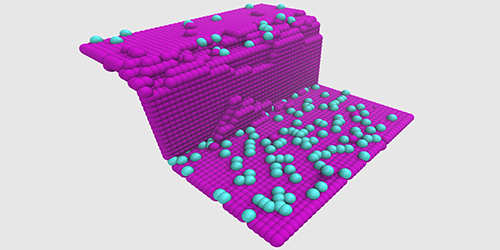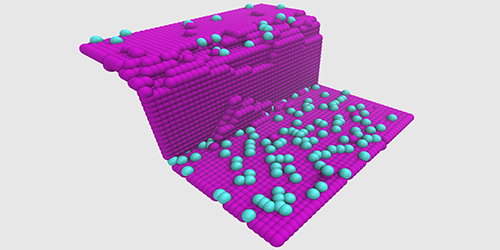Growing Crystals in Macrosteps
Crystals grow by adding layers that are typically one atom thick. As a layer expands over a surface, its leading edge behaves like a moving step. However, impurities can adhere to the crystal surface and obstruct this step motion. New atomic-scale simulations show how multiple steps pile up in front of these “road blocks,” creating a multilayer step, or macrostep, that is able to push past the impurities. This macrostep growth may explain how minerals and other crystals can form even when the density of impurities is high.
Early models of crystal step motion—dating back to the 1950s—showed how crowding could lead to macrosteps. These theories predicted that macrosteps moved slower than single-layer steps, like cars caught in a traffic jam. However, recent observations discovered that macrosteps could move under impurity conditions that halt the motion of single-layer steps.
To explain this unexpected behavior, Mike Sleutel from the Vrije Universiteit Brussel, Belgium, and his colleagues have performed atomic-scale simulations that detail the macrostep dynamics. Unlike previous work that typically averaged over fluctuations, the new simulations track how random absorption and desorption of atoms causes steps to move both forwards and backwards. On their simulated crystal surface, the team placed an “impurity fence,” which blocked single-layer steps but not macrosteps. In fact, the thicker the macrostep, the faster it moved over the impurities. The team identified two mechanisms to explain this behavior. One, the step crowding prevents atom desorption from lower steps, thus creating a kind of forward pressure that pushes the bottom step over the impurity barrier. Two, the macrostep offers a vertical surface on which atom clusters can stick to form a bridge over impurities.
This research is published in Physical Review Letters.
–Michael Schirber





